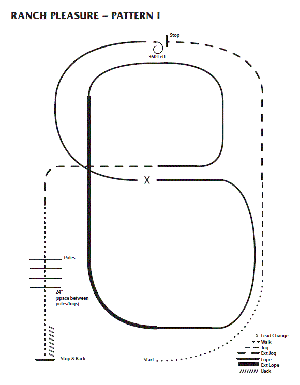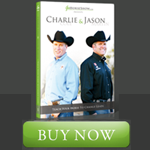The Southwest Quarter Horse Association February Show was the first show to put ranch pleasure on a show bill – the AQHA judges at the show chose Pattern 1.
A new American Quarter Horse Association ranch pleasure class yielded nine qualifiers for the 2012 AQHA World Championship Show.
AQHA added ranch pleasure as an open class in January, and the Southwest Quarter Horse Association February Show was the first show to put that class on the show bill.
“It was fantastic,” said Ferrell Morton, manager for the show in Las Cruces, New Mexico. “We had 41 entries. We had a lot of veteran exhibitors, who had drifted away (from showing in AQHA), who came back for it. The (horses) were (mostly) working horses, reiners, cow horses, that type of thing.”
Leanne Williams of Erie, Colorado, and Robert St. Clair of Falls of Rough, Kentucky, judged the show. They chose Pattern 1 for the first test of the new class.
“What I was looking for was a horse that I would take out on a working ranch, a horse I would take on a trail to get from Point A to Point B,” Williams said. “You don’t want a slow horse, you want a forward-moving horse, bright and alert. My emphasis was truly on horses that were broke and listening, but they also needed to be somewhat smooth.”
Ranch horse pleasure is a combined class, with open, amateur and youth exhibitors all showing in the one open-division class.
“It was a fresh new look,” St. Clair said. “It was kind of exciting. The exhibitors were all excited. It went off good. I think it’s going to be a popular class. It allows them to show the ranch-type horses the ranch type. They have to show extensions and work obstacles. I was really impressed with it.”
Horses will need two points to qualify in ranch pleasure for the 2012 World Show. Between the two judges, nine of the exhibitors from the SWQHA show earned at least two points.
In ranch horse pleasure, horses and riders enter the arena one at a time to perform a prescribed pattern. Pattern 1 calls for a walk, a jog, an extended jog, a change of leads, a 360-degree turn and a walk across poles.
“The poles definitely threw some of the horses,” Williams said. “I thought the class went over really positively. It took about two minutes per horse to run, and we used the whole arena, because the emphasis needs to be going forward. (Robert and I) pretty much had the same horses on our cards.
“We wanted horse that went straight and moved out when asked to,” she continued, “something you would enjoy riding. These guys were true cowboys. It was cold – wind-chill factor in 20s – but they were tough.”
St. Clair said the class didn’t require reining horses, but exhibitors needed to show horses with handling ability.
“We were looking for a horse you would ride on the ranch doing chores, and that’s the way they rode them,” he said.
Morton added that, overall, the show itself had more than 300 entries, with good classes throughout the two days of competition February 4-5.
“We’ve never had 300 in February before,” she said. “It was super, the way people received it.”
Horses entered in traditional western pleasure classes can’t also be entered in ranch pleasure, according to Patti Carter-Pratt, AQHA executive director of shows.
“Hoof polish and tail extensions are not allowed, and silver on saddles and bridles is discouraged,” Carter-Pratt said. “The class is going to bring a new group of horses to the show. It’s individually judged, with an excellent score sheet for member feedback. Horses shown in this class will earn AQHA Incentive Fund points and be able to qualify for the World Show.”
The watchword for the class is “forward.”
“The horses are to be judged on their movement in the required gaits along with the optional maneuvers. It’s more like a Versatility Ranch Horse ranch riding class, and the horses should perform accordingly,” said Alex Ross, AQHA senior director of judges. “They’ll be judged on movement, which is the cadence and rhythm of the gaits, smoothness, consistency in performance, but in all of that, when the horses are performing, they should be in a more forward gait than what you see in our normal western pleasure. Lack of forward motion will be penalized, and that’s emphasized.”
AQHA has some sample patterns in the AQHA Handbook of Rules & Regulations, but judges can also make up their own patterns as long as they include three of the five optional maneuvers and a change of direction somewhere in the pattern.
“The walk, the jog, extended jog, lope and extended lope will be required gaits,” Ross said, adding that the judge will select three of the five optional maneuvers: the sidepass; turns of 360 degrees or more; simple or flying lead changes; walking, jogging or loping over poles; or any other reasonable ranch maneuver.
The class should simulate how a rider might enjoy an American Quarter Horse riding across a pasture on a ranch. Because the horses will work individually, Carter-Pratt said, it will be up to the exhibitor to make sure the horse works at the correct rhythm and cadence for that horse.
“Exhibitors can move their horses forward and won’t have to worry about maintaining rail position to get the horse shown well,” she said. “Because they’re being shown individually, judges will be able to focus on manners, transitions and movement. It has a vintage feel to it.”
Ross was pleased that exhibitors in Las Cruces chose to take the class in the spirit it was intended.
“After talking to judges and spectators, it appears the first class was very successful,” he said. “There were a lot of quality horses, and it ran in a timely manner. I’m looking forward to seeing more as the year goes on.”








